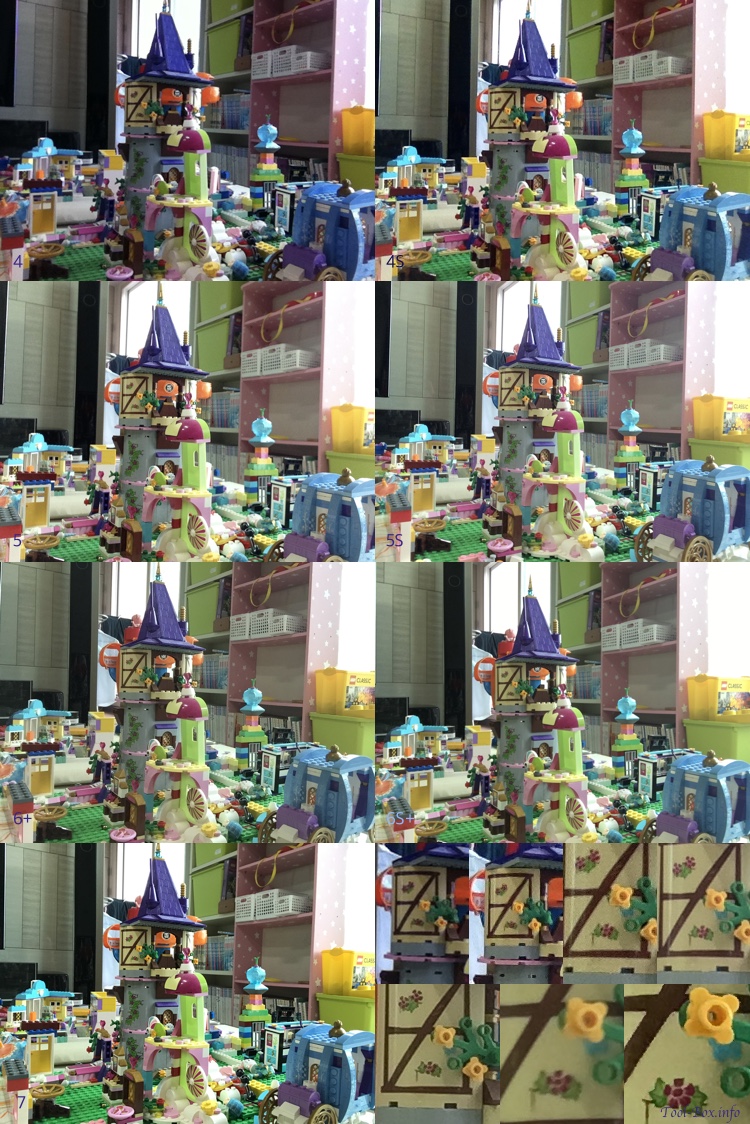Comparing iPhone 7 camera with older gen (Indoors)
Posted by Wesley on
Continuing from the last post, let's look at the indoor performance of the front camera. I took photos of a table in the living room where the kids have built what's essentially a toy village with Lego blocks. It should serve to show differences in colour reproduction, if any.
With the exception of iPhone 4, the colours look more or less correct, which is good. Also, the iPhone 7 did manage to take clear photos when the objects are closer, so it's doing a good job as its intended role of a selfie camera. 6S Plus result is fuzzier, but this time it can be attributed to a slight camera shake and would likely be nearly as good as 7 but with less pixels otherwise.
Next up, I took shots of the same scene with the rear camera, once with good indoor lighting and once with faint indirect lighting so I could observe how much noise can be seen for each cases. For the darker shots, I tried to have the camera maintain at or close to ISO 800 to make a close comparison.
| Original Photo | ISO | Shutter Speed |
|---|---|---|
| iPhone 7 | 80 | 1/30 |
| iPhone 6S+ | 32 | 1/17 |
| iPhone 6+ | 64 | 1/30 |
| iPhone 5S | 80 | 1/30 |
| iPhone 5 | 64 | 1/30 |
| iPhone 4S | 160 | 1/60 |
| iPhone 4 | 125 | 1/60 |
Next up, I took shots of the same scene with the rear camera, once with good indoor lighting and once with faint indirect lighting so I could observe how much noise can be seen for each cases. For the darker shots, I tried to have the camera maintain at or close to ISO 800 to make a close comparison.
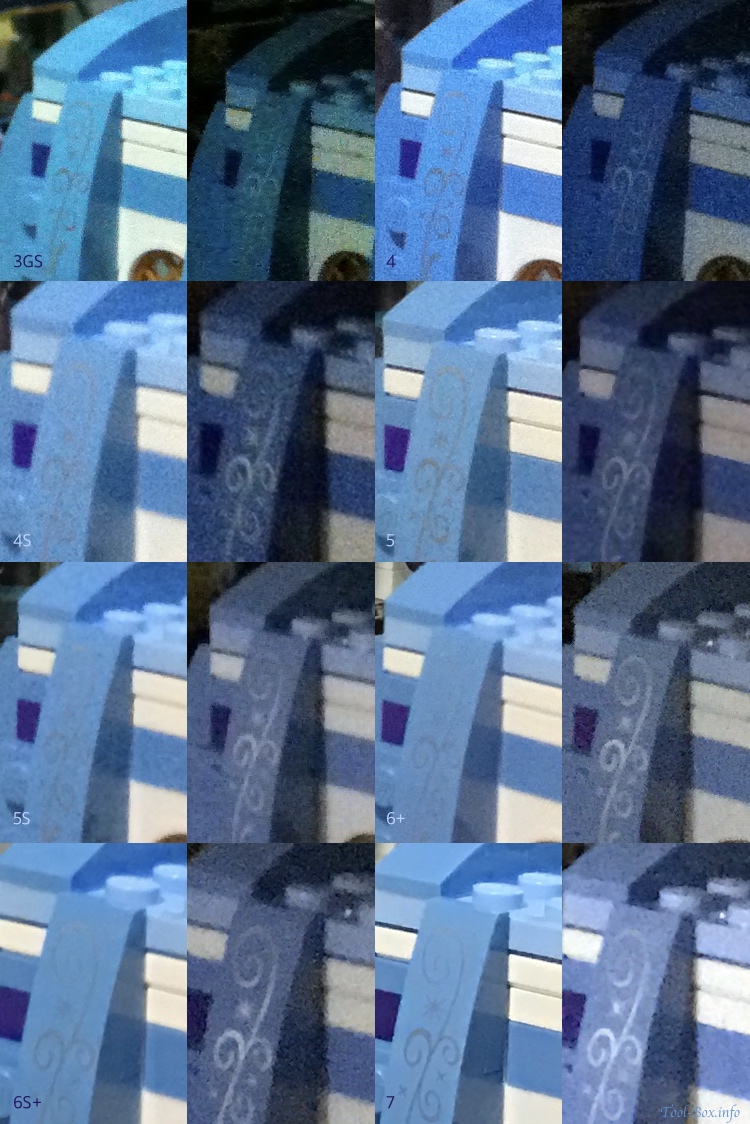
Noise level in bright and dim room - iPhone 3GS, 4, 4S, 5, 5S, 6 Plus, 6S Plus, and 7
| Bright Room | Dim Room | ||||
|---|---|---|---|---|---|
| Original Photo | ISO | Shutter | Original Photo | ISO | Shutter |
| iPhone 7 | 80 | 1/15 | iPhone 7 | 800 | 1/4 |
| iPhone 6S+ | 100 | 1/10 | iPhone 6S+ | 800 | 1/4 |
| iPhone 6+ | 125 | 1/15 | iPhone 6+ | 800 | 1/4 |
| iPhone 5S | 250 | 1/30 | iPhone 5S | 800 | 1/4 |
| iPhone 5 | 250 | 1/20 | iPhone 5 | 800 | 1/4 |
| iPhone 4S | 250 | 1/20 | iPhone 4S | 800 | 1/4 |
| iPhone 4 | 400 | 1/15 | iPhone 4 | 1000 | 1/15 |
| iPhone 3GS | 400 | 1/15 | iPhone 3GS | 1000 | 1/10 |
These crops at the original resolution reveal some interesting findings. At the well-lit room, the photos get progressively less grainy for newer models and by iPhone 6S Plus, it becomes quite smooth. This is not only because the sensors have gotten better, but also because the camera can shoot at a lower ISO thanks to brighter (smaller f-number) lens. As a result, you'll get noticeably better indoor shots with newer iPhones under the same condition.
At the dimly lit room, graininess in the photo is inevitable and it's up to the camera's processing algorithm to try smooth them out without losing too much detail. On that note, it seems that the techniques have varied over the years. Old devices like 3GS and 4 seems to have just left them alone, while 5, 5S, and 7 went for somewhat aggressive smoothing. The rest are in the middle ground.
Let's now move further extreme, where the room has hardly any illumination.
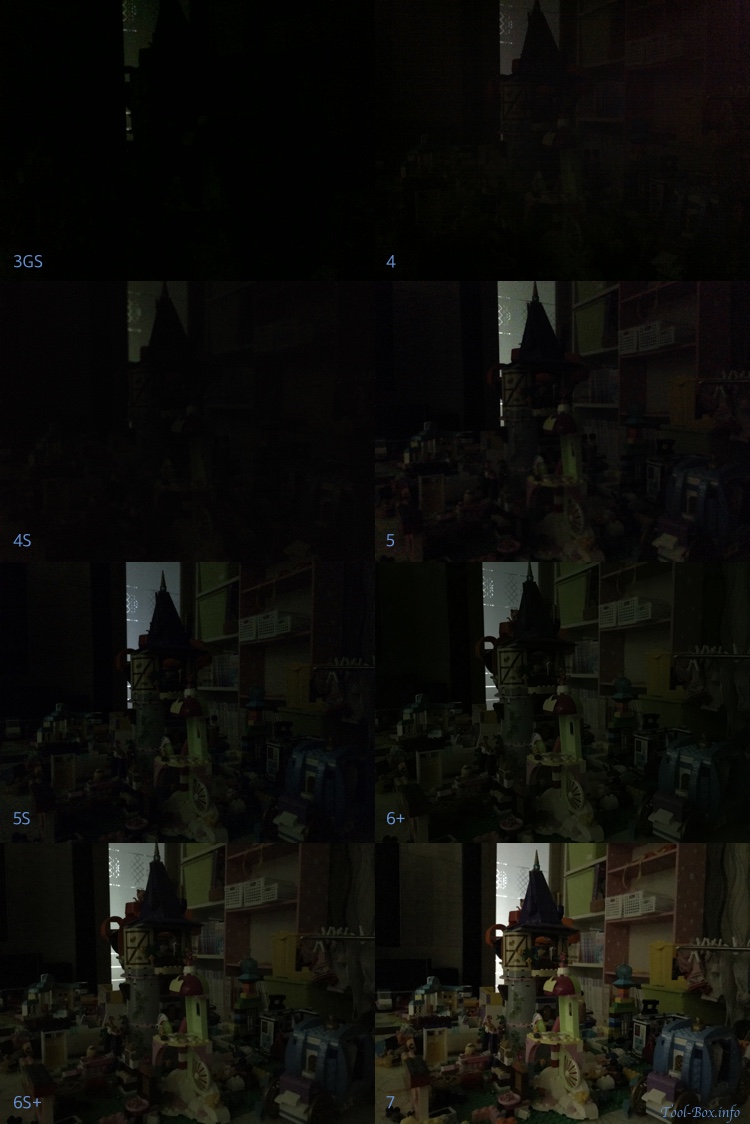
Sensitivity in the dark - iPhone 3GS, 4, 4S, 5, 5S, 6 Plus, 6S Plus, and 7
| Original Photo | ISO | Shutter Speed |
|---|---|---|
| iPhone 7 | 1600 | 1/15 |
| iPhone 6S+ | 2000 | 1/15 |
| iPhone 6+ | 500 | 1/4 |
| iPhone 5S | 2000 | 1/15 |
| iPhone 5 | 3200 | 1/15 |
| iPhone 4S | 800 | 1/15 |
| iPhone 4 | 1000 | 1/15 |
| iPhone 3GS | 1000 | 1/10 |
Brighter lenses and better sensors have again proven themselves in providing better and brighter low-light photos. In the old models, hardly anything is visible and the high ISO mode introduced in iPhone 5 was only good enough to make out the silhouette of the toy castle against the glass door. But with iPhone 7, you can discern pretty much all the toys on the table.
One thing to note here is that these were taken with the default camera app and in the case of the 6S Plus and 7, it seems to misreport the shutter speed in the low light situations. Although they are recorded as 1/4 seconds in the EXIF data, cross-checking with a 3rd party camera app reveal that they are actually 1/15 seconds. If you manually set for 1/4 seconds, you'll get a much brighter photo.
Of course, if you need to take shots in a much darker place, you might need to rely on a flash.
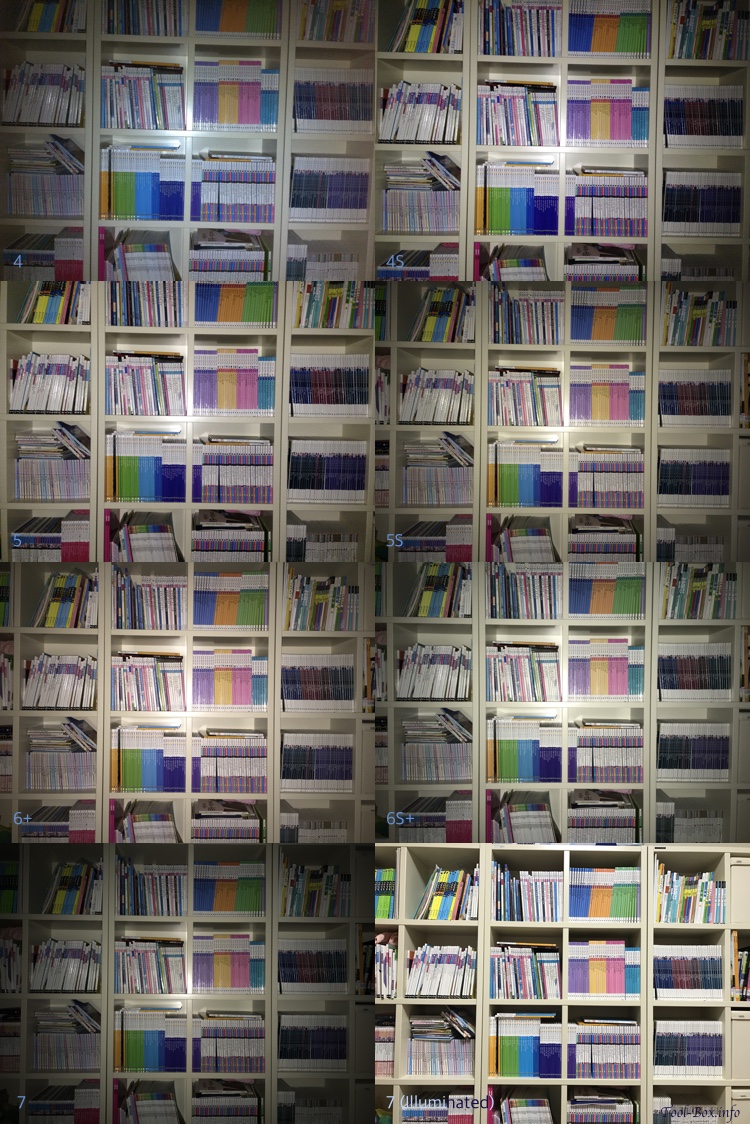
Flash photography - iPhone 4, 4S, 5, 5S, 6 Plus, 6S Plus, and 7, vs. iPhone 7 under illumination
| Original Photo | ISO | Shutter Speed |
|---|---|---|
| 7 (Illuminated) | 40 | 1/24 |
| iPhone 7 | 25 | 1/16 |
| iPhone 6S+ | 125 | 1/16 |
| iPhone 6+ | 160 | 1/16 |
| iPhone 5S | 125 | 1/16 |
| iPhone 5 | 200 | 1/16 |
| iPhone 4S | 200 | 1/16 |
| iPhone 4 | 400 | 1/17 |
With the peculiar exception of iPhone 7, all the photos with flash have similar brightness. The story of the older iPhones needing higher ISO setting for the same condition continues here. So what is the deal with iPhone 7? Is its flash suddenly less powerful than the rest? Far from it. If you look at the camera settings, iPhone 7 was taking the photo at ISO 25, five times lower than 6S Plus. So if all things were equal, the photo should've been even darker. Therefore, the phone seems to be trying to avoid overexposure from the flash more aggressively than before. After all, I was shooting a glossy bookcase full of hardcovers and you can notice how the center is overexposed quite a bit in the other photos. To confirm this, I shot some much less reflective objects - rows of seats in an auditorium:
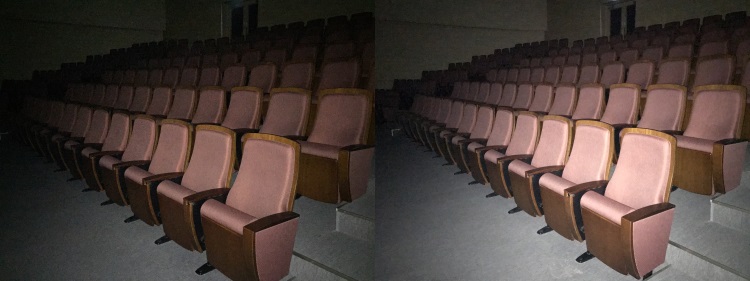
Left: iPhone 6, ISO 2000, 1/16s | Right: iPhone 7, ISO 1600, 1/16s
As you can see, iPhone 7 can indeed take much brighter flash photos as long as it feels they are not overexposed. So the bookcase scene was more of a quirk than a norm.
Meanwhile, colour reproduction shows the advantage of the True Tone flash rather well. Models before its inclusion, up to iPhone 5, show a 'colder' look of the scene in general. Models with this flash put out more natural-looking colours. On the iPhone 7, True Tone flash was upgraded to have four LEDs instead of two for even more accurate results, but it's hard to tell from from here. It might shine in a more extreme situation, perhaps.
In conclusion, there is no doubt that the iPhone cameras have gotten better every year, and iPhone 7's sensor and lens combination has brought the quality game to the next level. No matter what older iPhone you were using before, the new camera should not disappoint.
Defined tags for this entry: camera, iPhone 3GS, iPhone 4, iPhone 4S, iPhone 5, iPhone 5S, iPhone 6 Plus, iPhone 6+, iPhone 6S Plus, iPhone 7
